Assessment of Integrated Coastal Vulnerability Index in the Coromandel Coast of Tamil Nadu, India Using Multi-Criteria Spatial Analysis Approaches
Abstract
1. Introduction
2. Materials and Methods
2.1. Study Area
2.2. Analytical Techniques of Coastal Vulnerability Index Using Geospatial Tools
2.3. Calculation of Integrated Coastal Vulnerability Index (ICVI)
2.3.1. Physical Vulnerability Index (PVI)
2.3.2. Socioeconomic Vulnerability Index (SEVI)
2.3.3. Climatic Vulnerability Index (CVIc)
3. Results
3.1. Various Parameters of Coromandel Coast
3.1.1. Physical Vulnerability Parameters of the Study Area
3.1.2. The Role of Socioeconomic Parameters on the Coromandel Coast
3.1.3. The Role of Climatic Parameters on the Coromandel Coast
3.2. Coastal Vulnerability Assessment
3.2.1. Zone 1: Thiruvallur to Puducherry
3.2.2. Zone 2: Cuddalore to Thiruvarur
3.2.3. Zone 3: Thanjavur to Ramanathapuram
3.2.4. Zone 4: Ramanathapuram to Kanyakumari
4. Discussion
5. Conclusions
Author Contributions
Funding
Institutional Review Board Statement
Informed Consent Statement
Data Availability Statement
Acknowledgments
Conflicts of Interest
References
- Šimac, Z.; Lončar, N.; Faivre, S. Overview of Coastal Vulnerability Indices with Reference to Physical Characteristics of the Croatian Coast of Istria. Hydrology 2023, 10, 14. [Google Scholar] [CrossRef]
- Turriza Canul, R.A.; Fernández-Díaz, V.Z.; Rojas Cárdenas, D.M.; Tzuc, Ó.M. Coastal vulnerability assessment with a hierarchical coastal segments approach. Ocean Coast. Manag. 2024, 249, 106989. [Google Scholar] [CrossRef]
- Parthasarathy, K.S.S.; Deka, P.C. Remote sensing and GIS application in assessment of coastal vulnerability and shoreline changes: A review. ISH J. Hydraul. Eng. 2021, 27 (Suppl. S1), 588–600. [Google Scholar] [CrossRef]
- Velegrakis, A.F.; Monioudi, I.; Tzoraki, O.; Vousdoukas, M.I.; Tragou, E.; Hasiotis, T.; Asariotis, R.; Andreadis, O. Coastal Hazards and Related Impacts in Greece. In The Geography of Greece: Managing Crises and Building Resilience; Darques, R., Sidiropoulos, G., Kalabokidis, K., Eds.; Springer: Cham, Switzerland, 2024; pp. 353–370. [Google Scholar] [CrossRef]
- Small, C.; Nicholls, R.J. A Global Analysis of Human Settlement in Coastal Zones. J. Coast. Res. 2003, 19, 584–599. [Google Scholar]
- Grothues, T.M.; Padilla, D.K.; Kolatan, S.; Kaunzinger, C.M.K.; Parker, P.; Handel, S.N. Life as a Design Element of Hardened Urban Shorelines. Estuaries Coasts 2025, 48, 48. [Google Scholar] [CrossRef]
- Hamid, N.; Yoganandham, S.T. An Introduction to Marine Ecosystem: Environmental and Economic Impacts. In Advances in Marine Ecosystem Research; Springer: Cham, Switzerland, 2025; pp. 1–20. [Google Scholar] [CrossRef]
- Dong, Y. The impact of tourists on the marine environment: A review and managerial implications. Reg. Environ. Chang. 2025, 25, 2385. [Google Scholar] [CrossRef]
- Ali, E.M.; Zanaty, N.; Khairy, N.; El-Magd, I.A. Assessment of Climate Change Implications on Coastal and Marine Ecosystems Using Satellite Data. In Modelling and Advanced Earth Observation Technologies for Coastal Zone Management; Ali, E.M., El-Magd, I.A., Eds.; Springer Nature Switzerland: Cham, Switzerland, 2025; pp. 85–115. ISBN 978-3-031-78768-3. [Google Scholar]
- Ford-Learner, M.A.; Addison, J.; Cumming, G.S. A Review of Ecosystem Service Supply in Tropical Marine Ecosystems and Its Relationship to Habitats in the Great Barrier Reef. Mar. Ecosyst. Ecol. 2024, in press. [Google Scholar] [CrossRef]
- Gornitz, V.; White, T.W.; Cushman, R.M. Vulnerability of the US to Future Sea Level Rise; Report No.: CONF-910780-1; Oak Ridge National Lab.: Oak Ridge, TN, USA, 1991. [Google Scholar]
- Deb, D.; Uddin, M.M.; Mahbub-E-Kibria, A.S.M.; Das, M.K.; Hasan, M. Coastal vulnerability assessment to multi hazards in the exposed coast of Southeastern Coastal Region of Bangladesh. Int. J. Disaster Risk Reduct. 2024, 85, 103791. [Google Scholar] [CrossRef]
- Kantamaneni, K.; Xing, L.; Gupta, V.; Campos, L.C. Vulnerability assessment of English and Welsh coastal areas. Sci. Rep. 2024, 14, 78238. [Google Scholar] [CrossRef]
- Theocharidis, C.; Doukanari, M.; Kalogirou, E.; Demetriou, D.C.; Mettas, C.; Kontoes, C.; Hadjimitsis, D.G.; Argyriou, A.V.; Eliades, M. Coastal Vulnerability Index (CVI) Assessment: Evaluating Risks Associated with Human-Made Activities along the Limassol Coastline, Cyprus. Environ. Sci. Pollut. Res. 2024, 31, 53749–53766. [Google Scholar] [CrossRef]
- Boumpoulis, V.; Depountis, N.; Dimas, A.; Papatheodorou, G. Presentation and analysis of the Geotechnical Coastal Vulnerability Index and validation of its application to coastal erosion problems. Sci. Rep. 2025, 15, 85594. [Google Scholar] [CrossRef] [PubMed]
- Marzouk, M.; Azab, S. Modeling climate change adaptation for sustainable coastal zones using GIS and AHP. Environ. Monit. Assess. 2024, 196, 12287. [Google Scholar] [CrossRef] [PubMed]
- Sethuraman, S.; Alshahrani, H.M.; Tamizhselvi, A.; Sujaatha, A. Assessment of coastal vulnerability using AHP and machine learning techniques. Mar. Pet. Geol. 2024, 144, 106989. [Google Scholar] [CrossRef]
- Gaki-Papanastassiou, K.; Karymbalis, E.; Serafim, P.; Zouva, C. Coastal vulnerability assessment to sea-level rise based on geomorphological and oceanographical parameters: The case of Argolikos Gulf, Peloponnese, Greece. Hell. J. Geosci. 2010, 45, 109–122. [Google Scholar]
- Arda, T.; Bayrak, O.C.; Uzar, M. Analyzing Coastal Vulnerability Using Analytic Hierarchy Process and Best–Worst Method: A Case Study of the Marmara Gulf Region. Arab. J. Sci. Eng. 2025, 50, 1851–1869. [Google Scholar] [CrossRef]
- ElKotby, M.R.; Sarhan, T.A.; El-Gamal, M.; Masria, A. Evaluation of Coastal Risks to Sea Level Rise: Case Study of Nile Delta Coast. Reg. Stud. Mar. Sci. 2024, 78, 103791. [Google Scholar] [CrossRef]
- Nourdi, N.F.; Raphael, O.; Achab, M.; Loudi, Y.; Rudant, J.-P.; Minette, T.E.; Kambia, P.; Claude, N.J.; Romaric, N. Integrated Assessment of Coastal Vulnerability in the Bonny Bay: A Combination of Traditional Methods (Simple and AHP) and Machine Learning Approach. Estuaries Coasts 2024, 47, 2670–2695. [Google Scholar] [CrossRef]
- Akash, S.H.; Sarkar, S.K.; Bindajam, A.A.; Kumari, R.; Talukdar, S.; Mallick, J. Assessment of Coastal Vulnerability Using Integrated Fuzzy Analytical Hierarchy Process and Geospatial Technology for Effective Coastal Management. Environ. Sci. Pollut. Res. 2024, 31, 53749–53766. [Google Scholar] [CrossRef]
- Nath, A.; Koley, B.; Choudhury, T.; Biswas, A. Prioritizing Flood Drivers: An AHP-Based Study of Physical Factors in Digha’s Coastal Belt, East Coast, India. Spat. Inf. Res. 2025, 33, 12. [Google Scholar] [CrossRef]
- Sood, A.; Vignesh, K.S.; Prapanchan, V.N. Multi-Hazard Vulnerability Zone Identification Using GIS-Based Fuzzy AHP and MCDM Techniques. Nat. Hazards 2025, 121, 8501–8539. [Google Scholar] [CrossRef]
- Liu, J.; Liu, X.; Zhu, A.; Wang, X.; Yu, Q.; Chen, L.; Al-Musawi, T.J.; Aasal, M. Prioritization of Climate Change Mitigation Strategies for Coastal Regions Using the Analytic Hierarchy Process. Mar. Pollut. Bull. 2025, 212, 117516. [Google Scholar] [CrossRef] [PubMed]
- Fuentes, J.E.; Olaya, R.A.; Garcia, C.E. Evaluation of Coastal Erosion in the Watersheds of Municipality of Buenaventura, Colombia: Using Geospatial Techniques and the Composite Vulnerability Index. ISPRS Int. J. Geo-Inf. 2022, 11, 568. [Google Scholar] [CrossRef]
- Tursi, M.F.; Anfuso, G.; Matano, F.; Mattei, G.; Aucelli, P.P.C. A Methodological Tool to Assess Erosion Susceptibility of High Coastal Sectors: Case Studies from Campania Region (Southern Italy). Water 2023, 15, 121. [Google Scholar] [CrossRef]
- Rizzo, A.; Aucelli, P.P.C.; Gracia, F.J.; Anfuso, G. A Novelty Coastal Susceptibility Assessment Method: Application to Valdelagrana Area (SW Spain). J. Coast. Conserv. 2018, 22, 973–987. [Google Scholar] [CrossRef]
- Rangel-Buitrago, N.; Anfuso, G. Risk Assessment of Storms in Coastal Zones: Case Studies from Cartagena (Colombia) and Cadiz (Spain); Springer: Cham, Switzerland, 2015. [Google Scholar] [CrossRef]
- Tursi, M.F.; Anfuso, G.; Matano, F.; Aucelli, P.P.C.; Mattei, G. A Multi-Component Approach to Predict Erosion Susceptibility of Rocky Coasts: Marine, Terrestrial and Climatic Forcing—An Application in Southern Italy. Environ. Earth Sci. 2025, 84, 183. [Google Scholar] [CrossRef]
- Anfuso, G.; Gracia, F.J.; Battocletti, G. Determination of Cliffed Coastline Sensitivity and Associated Risk for Human Structures: A Methodological Approach. J. Coast. Res. 2013, 29, 1292–1296. [Google Scholar] [CrossRef]
- Mooser, A.; Anfuso, G.; Williams, A.T.; Molina, R.; Aucelli, P.P.C. An Innovative Approach to Determine Coastal Scenic Beauty and Sensitivity in a Scenario of Increasing Human Pressure and Natural Impacts Due to Climate Change. Water 2020, 13, 49. [Google Scholar] [CrossRef]
- Abijith, D.; Saravanan, S.; Sundar, P.K.S. Coastal Vulnerability Assessment for the Coast of Tamil Nadu, India—A Geospatial Approach. Environ. Sci. Pollut. Res. 2023, 30, 75610–75628. [Google Scholar] [CrossRef]
- Sekar, L.G.; Androws, X.; Annaidasan, K.; Kumar, A.; Kannan, R.; Muthusankar, G.; Balasubramani, K. Assessment of Shoreline Changes and Associated Erosion and Accretion Pattern in Coastal Watersheds of Tamil Nadu, India. Nat. Hazards Res. 2024, 4, 231–238. [Google Scholar] [CrossRef]
- de Andrade Rodrigues, G.; de Souza Filho, F.A.; Nelson, D.R.; Rocha, R.V.; da Silva, S.M.O. Development of a Drought Vulnerability Index Using MCDM and GIS: Study Case in São Paulo and Ceará, Brazil. Nat. Hazards 2020, 104, 1781–1799. [Google Scholar] [CrossRef]
- Nigam, R.; Luis, A.J.; Gagnon, A.S.; Vaz, E.; Damásio, B.; Kotha, M. Assessing coastal vulnerability at the village level using a robust framework, the example of Canacona in South Goa, India. iScience 2024, 27, 109129. [Google Scholar] [CrossRef] [PubMed]
- Thieler, E.R.; Hammar-Klose, E.S. National Assessment of Coastal Vulnerability to Sea-Level Rise: Preliminary Results for the U.S. Pacific Coast; U.S. Geological Survey: Reston, VA, USA, 2000; p. 22.
- Bagdanavičiūtė, I.; Kelpšaitė, L.; Soomer, T. Multi-criteria evaluation approach to coastal vulnerability index development in micro-tidal low-lying areas. Ocean Coast. Manag. 2015, 104, 122–136. [Google Scholar] [CrossRef]
- Pramanik, M.K.; Dash, P.; Behal, D. Improving outcomes for socioeconomic variables with coastal vulnerability index under significant sea-level rise: An approach from Mumbai coasts. Environ. Dev. Sustain. 2021, 23, 13819–13853. [Google Scholar] [CrossRef]
- Karymbalis, E.; Papanastassiou, D.; Chalkias, C.; Gaki-Papanastassiou, K.; Skilodimou, H.D. Assessment of the sensitivity of the southern coast of the Gulf of Corinth (Peloponnese, Greece) to sea-level rise. Cent. Eur. J. Geosci. 2012, 4, 561–577. [Google Scholar] [CrossRef]
- Gornitz, V.M.; Daniels, R.C.; White, T.W.; Birdwell, K.R. The Development of a Coastal Risk Assessment Database: Vulnerability to Sea-Level Rise in the US Southeast. J. Coast. Res. 1994, 12, 327–338. [Google Scholar]
- Valdivia-Quidel, P.; Díaz, M.E.; Aguayo, C.; Esse, C.; Muñoz-Pedreros, A.; Guerrero, M.; Figueroa, D. A spatial multi-criteria analysis for the identification of preferential areas for recreational fishing in Chile. GeoJournal 2023, 88, 4441–4455. [Google Scholar] [CrossRef]
- Dibba, B.; Yaffa, S.; Sawaneh, M.; Adzawla, W. Land Cover Transformation and Population Growth: Impacts on Coastal Environment of The Gambia (1990–2020). Sustainability 2025, 17, 1853. [Google Scholar] [CrossRef]
- Leandro, V.; Pereira, E.; Pluvie, L.; Silva, R.; Dias, F. Analysis of Coastal Environmental Vulnerabilities in the Municipality of Niterói, Rio de Janeiro, Brazil, in the Face of Sea Level Rise Projections. Coasts 2025, 5, 11. [Google Scholar] [CrossRef]
- Kemarau, R.A.; Suab, S.A.; Eboy, O.V.; Sa’adi, Z.; Echoh, D.U.; Sakawi, Z. Integrative Approaches in Remote Sensing and GIS for Assessing Climate Change Impacts Across Malaysian Ecosystems and Societies. Sustainability 2025, 17, 1344. [Google Scholar] [CrossRef]
- Monioudi, I.; Chatzistratis, D.; Chalazas, T.; Chatzipavlis, A.; Velegrakis, A.; Andreadis, O.; Monioudis, E.; Nikolaou, A.; Hasiotis, T. A Prioritization Framework for Adaptation Responses for Climate Change-Induced Erosion in Island Beaches—Cases from the Aegean Islands, Greece. J. Mar. Sci. Eng. 2025, 13, 491. [Google Scholar] [CrossRef]
- Ramachandran, A.; Khan, A.S.; Palanivelu, K.; Prasannavenkatesh, R.; Jayanthi, N. Projection of Climate Change-Induced Sea-Level Rise for the Coasts of Tamil Nadu and Puducherry, India Using SimCLIM: A First Step towards Planning Adaptation Policies. J. Coast. Conserv. 2017, 21, 731–742. [Google Scholar] [CrossRef]
- Scala, P.; Manno, G.; Cozar, L.C.; Ciraolo, G. COAST-PROSIM: A Model for Predicting Shoreline Evolution and Assessing the Impacts of Coastal Defence Structures. Water 2023, 17, 269. [Google Scholar] [CrossRef]
- Pendleton, E.A.; Thieler, E.R.; Williams, S.J.; Beavers, R.L. Coastal Vulnerability Assessment of Padre Island National Seashore (PAIS) to Sea-Level Rise; U.S. Geological Survey: Reston, VA, USA, 2004. Available online: https://pubs.usgs.gov/of/2004/1090/ (accessed on 1 April 2025).
- Vasudevan, S.; Sajeev, R.; Ramakrishnan, R. Assessment of Shoreline Dynamics and Vulnerability along the Central Kerala Coast Using a Geospatial Approach. Mar. Georesour. Geotechnol. 2024, in press. [Google Scholar] [CrossRef]
- Baig, M.R.I.; Shahfahad; Ahmad, I.A.; Tayyab, M.; Asgher, M.S.; Rahman, A. Coastal Vulnerability Mapping by Integrating Geospatial Techniques and Analytical Hierarchy Process (AHP) along the Vishakhapatnam Coastal Tract, Andhra Pradesh, India. J. Indian Soc. Remote Sens. 2021, 49, 215–231. [Google Scholar] [CrossRef]
- Arun Kumar, A.; Kunte, P.D. Coastal Vulnerability Assessment for Chennai, East Coast of India Using Geospatial Techniques. Nat. Hazards 2012, 64, 853–872. [Google Scholar] [CrossRef]
- Tchindjang, M.; Mbevo, F.P.; Kamgho, C. Coastal Hazard and Vulnerability Assessment in Cameroon. Int. J. Clim. Chang. Strateg. Manag. 2024. ahead-of-print. Available online: https://www.proquest.com/docview/3159530022?fromopenview=true&pq-origsite=gscholar (accessed on 1 April 2025). [CrossRef]
- McLaughlin, S.; Cooper, J.A.G. A Multi-Scale Coastal Vulnerability Index: A Tool for Coastal Managers. Environ. Hazards 2010, 9, 233–248. [Google Scholar] [CrossRef]
- Alawna, S.; Garcia, X. Spatial and Temporal Climate Change Vulnerability Assessment in the West Bank, Palestine. Environments 2025, 12, 69. [Google Scholar] [CrossRef]
- Devanantham, A.; Saravanan, S.; Parthasarathy, K.S.S.; Reddy, N.M.; Niraimathi, J.; Bindajam, A.A.; Mallick, J.; Alharbi, M.M.; Abdo, H.G. Assessing the Impact of Climate and Land Use Change on Flood Vulnerability: A Machine Learning Approach in Coastal Region of Tamil Nadu, India. Geosci. Lett. 2025, 12, 15. [Google Scholar] [CrossRef]
- Ramachandran, A.; Praveen, D.; Radhapriya, P.; Divya, S.K.; Remya, K.; Palanivelu, K. Vulnerability and Adaptation Assessment—A Way Forward for Sustainable Sectoral Development in the Purview of Climate Variability and Change: Insights from the Coast of Tamil Nadu, India. Int. J. Glob. Warm. 2016, 10, 303–324. [Google Scholar] [CrossRef]
- Mourato, S.; Fernandez, P.; Gomes Pereira, L.; Moreira, M. Assessing Vulnerability in Flood Prone Areas Using Analytic Hierarchy Process—Group Decision Making and Geographic Information System: A Case Study in Portugal. Appl. Sci. 2023, 13, 4915. [Google Scholar] [CrossRef]
- Barbara, C.B.; D’Ambrosio, V.; Di Martino, F.; Miraglia, V. Hierarchical Fuzzy MCDA Multi-Risk Model for Detecting Critical Urban Areas in Climate Scenarios. Appl. Sci. 2024, 14, 3066. [Google Scholar] [CrossRef]
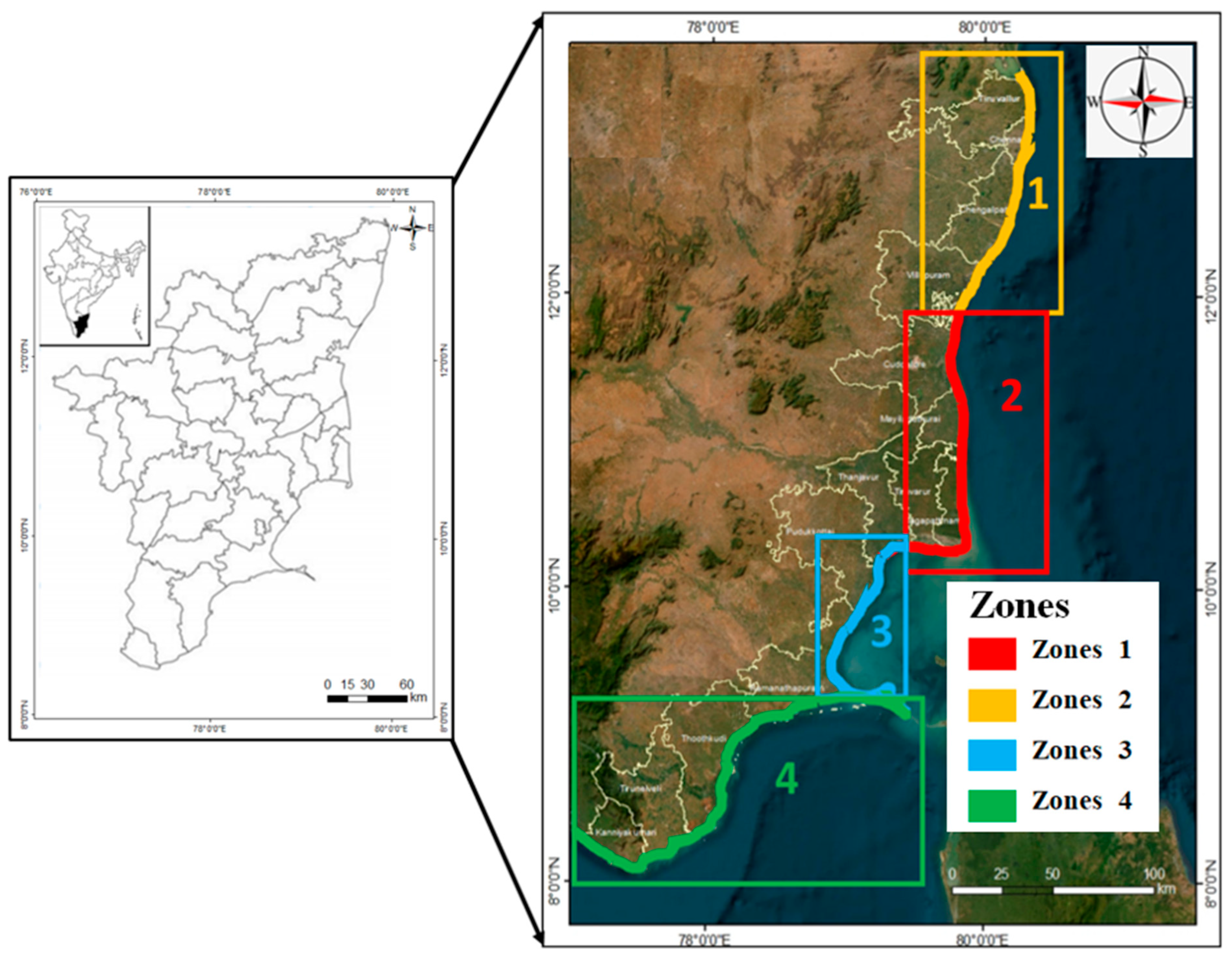
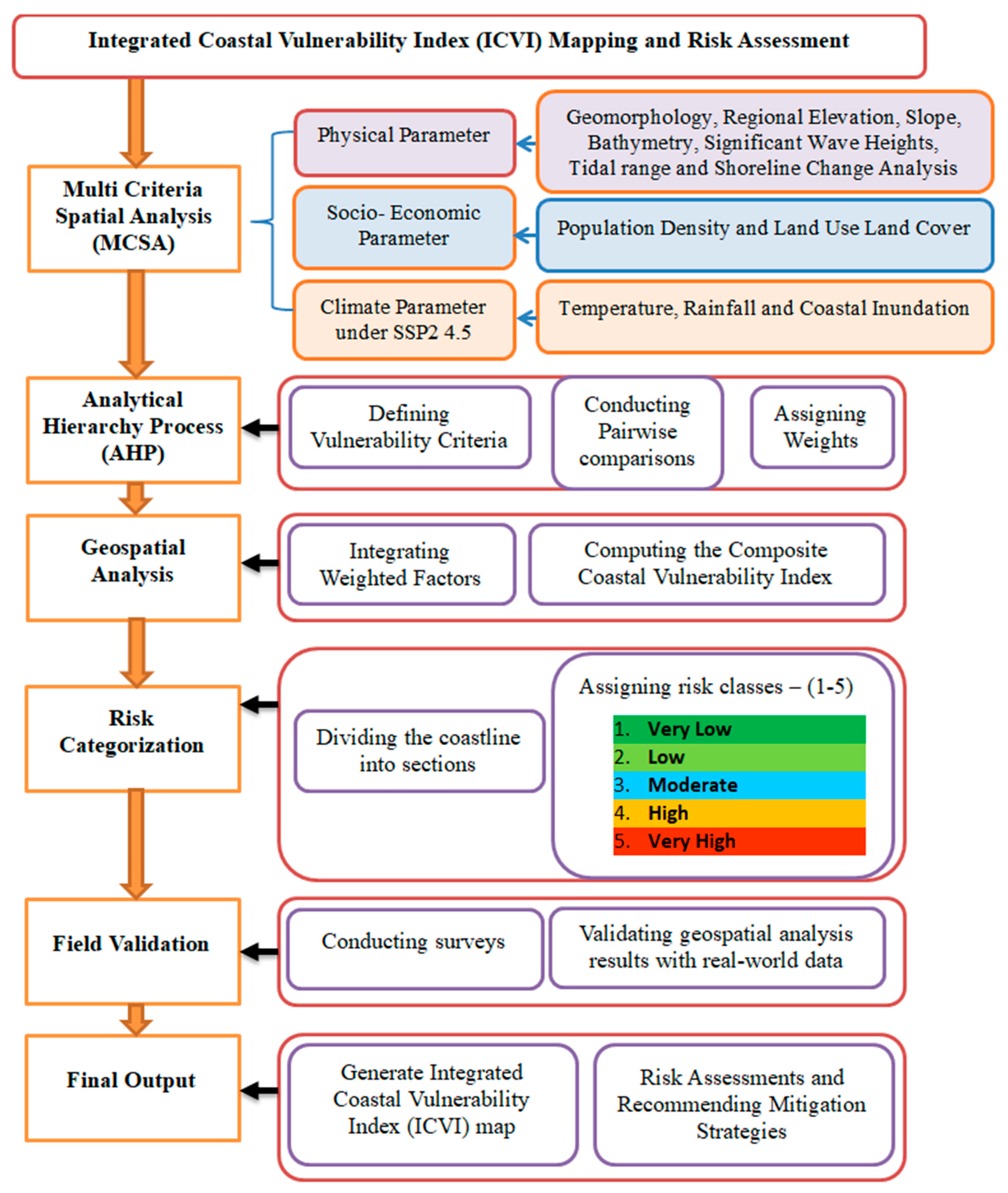

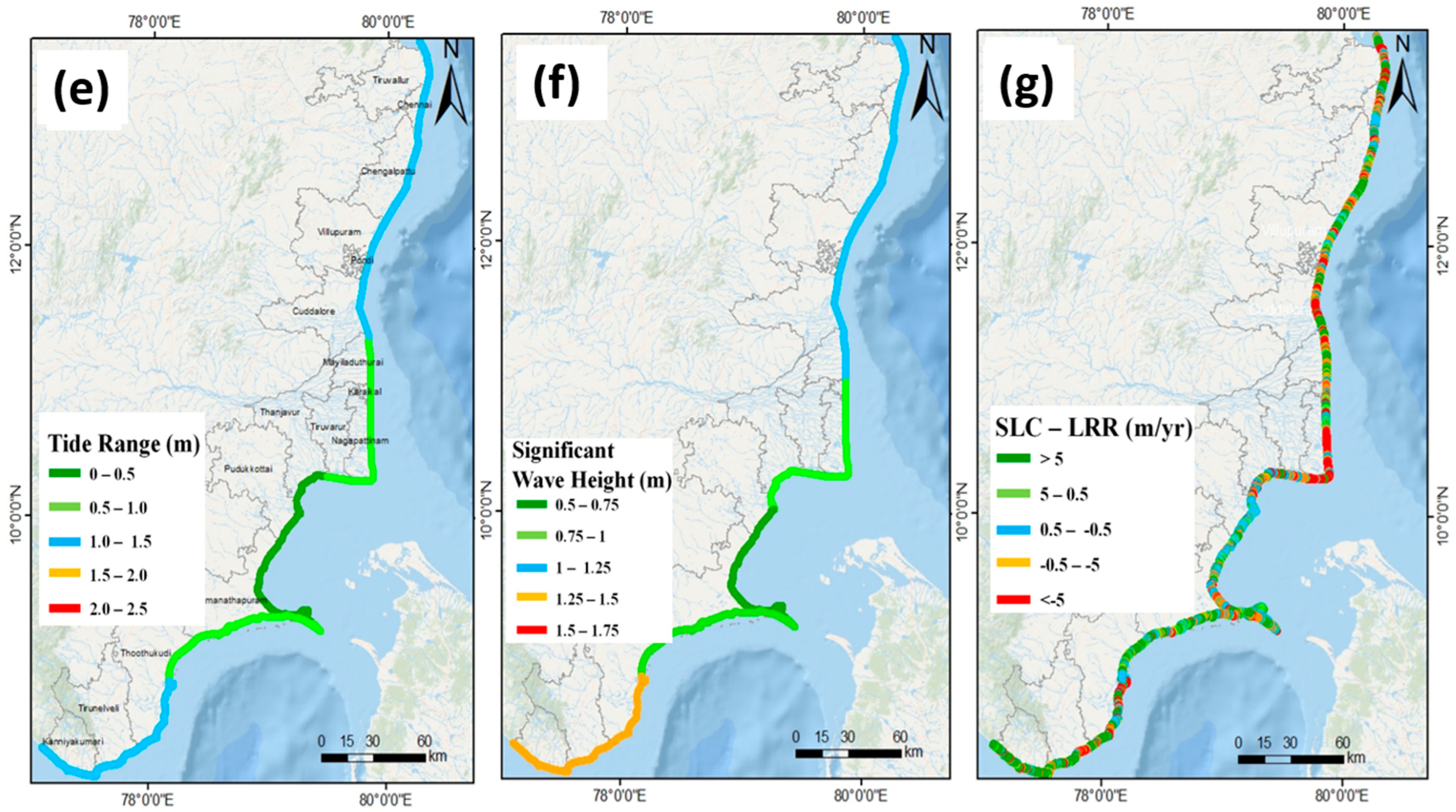
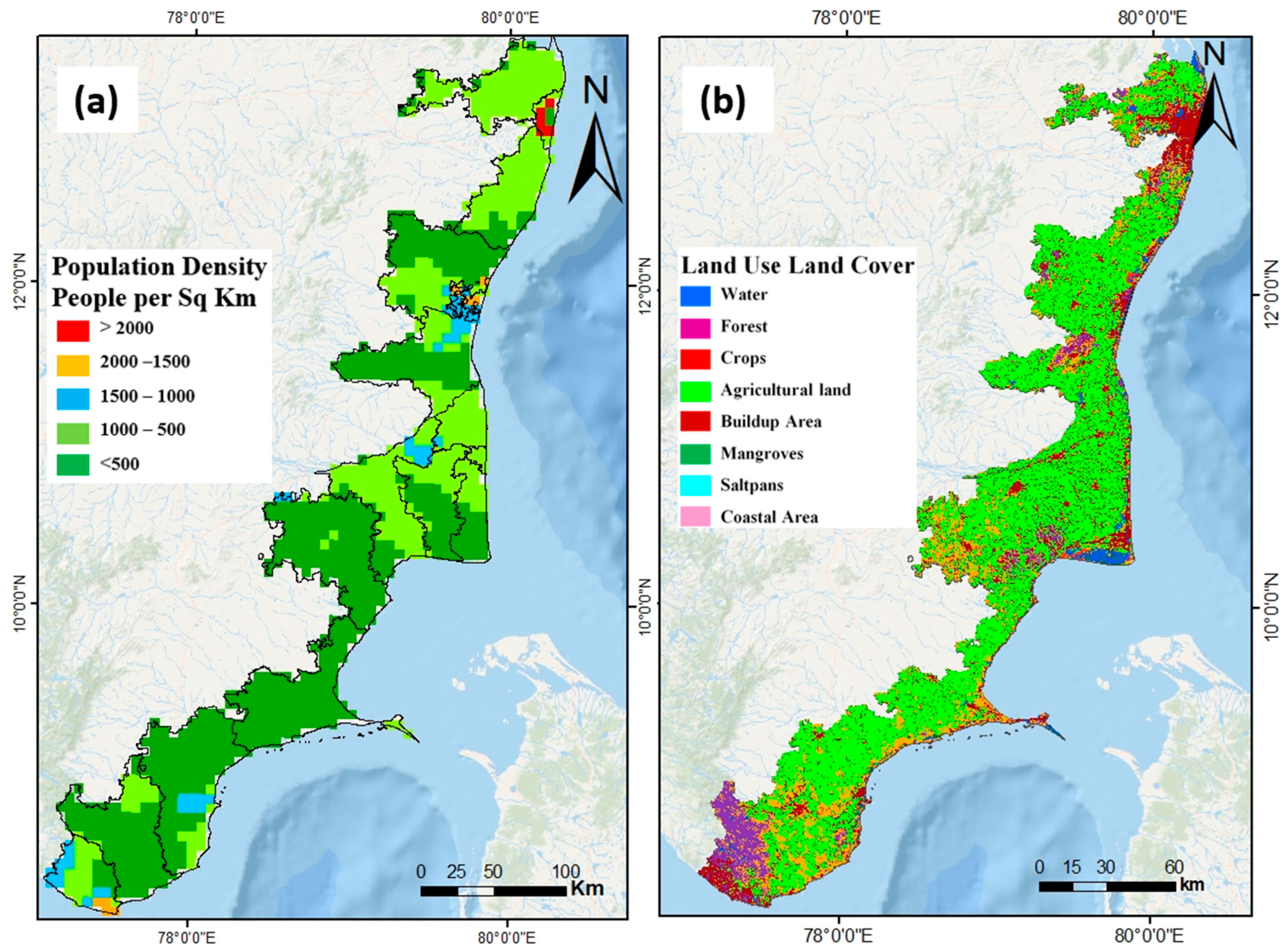
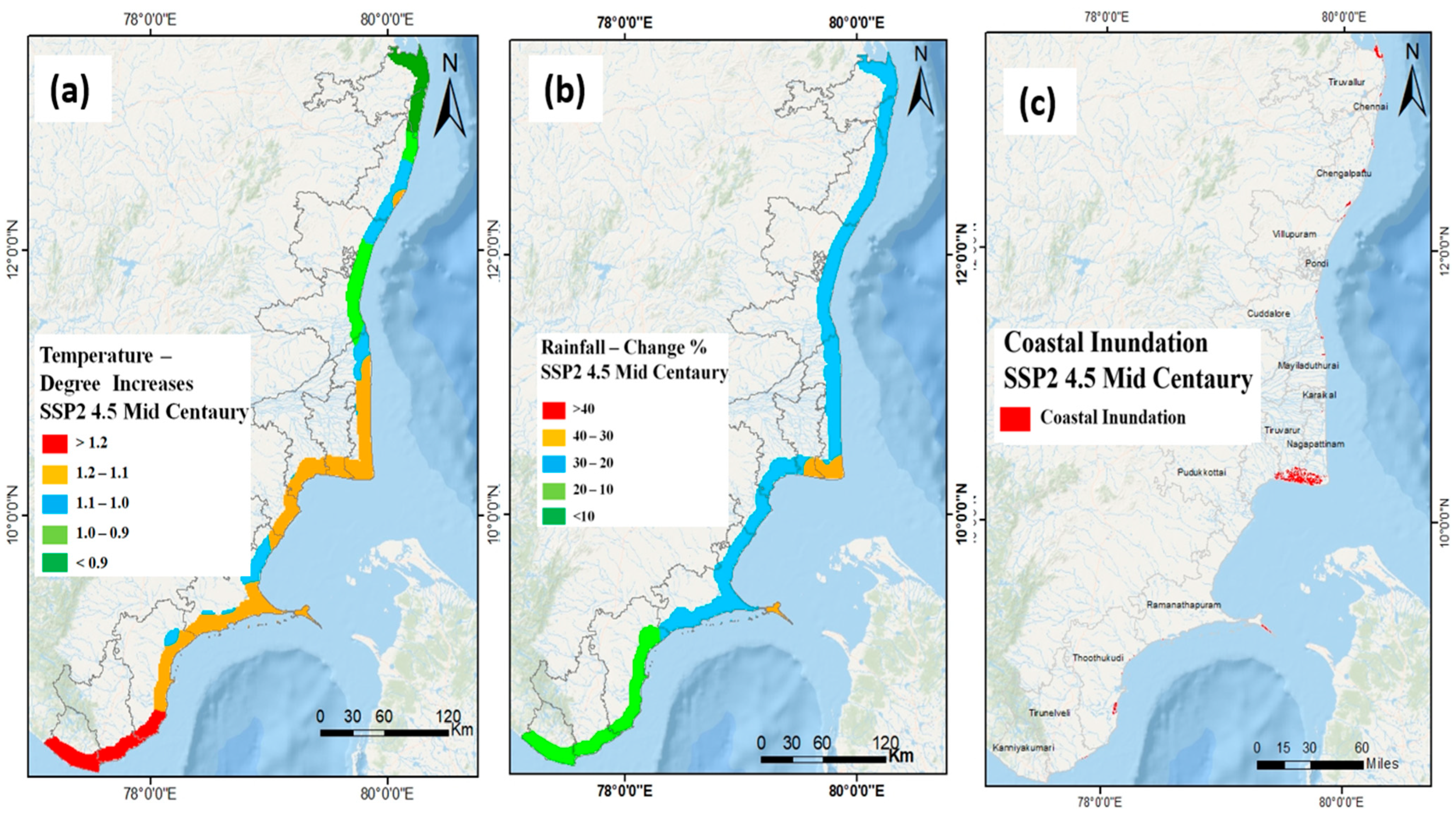

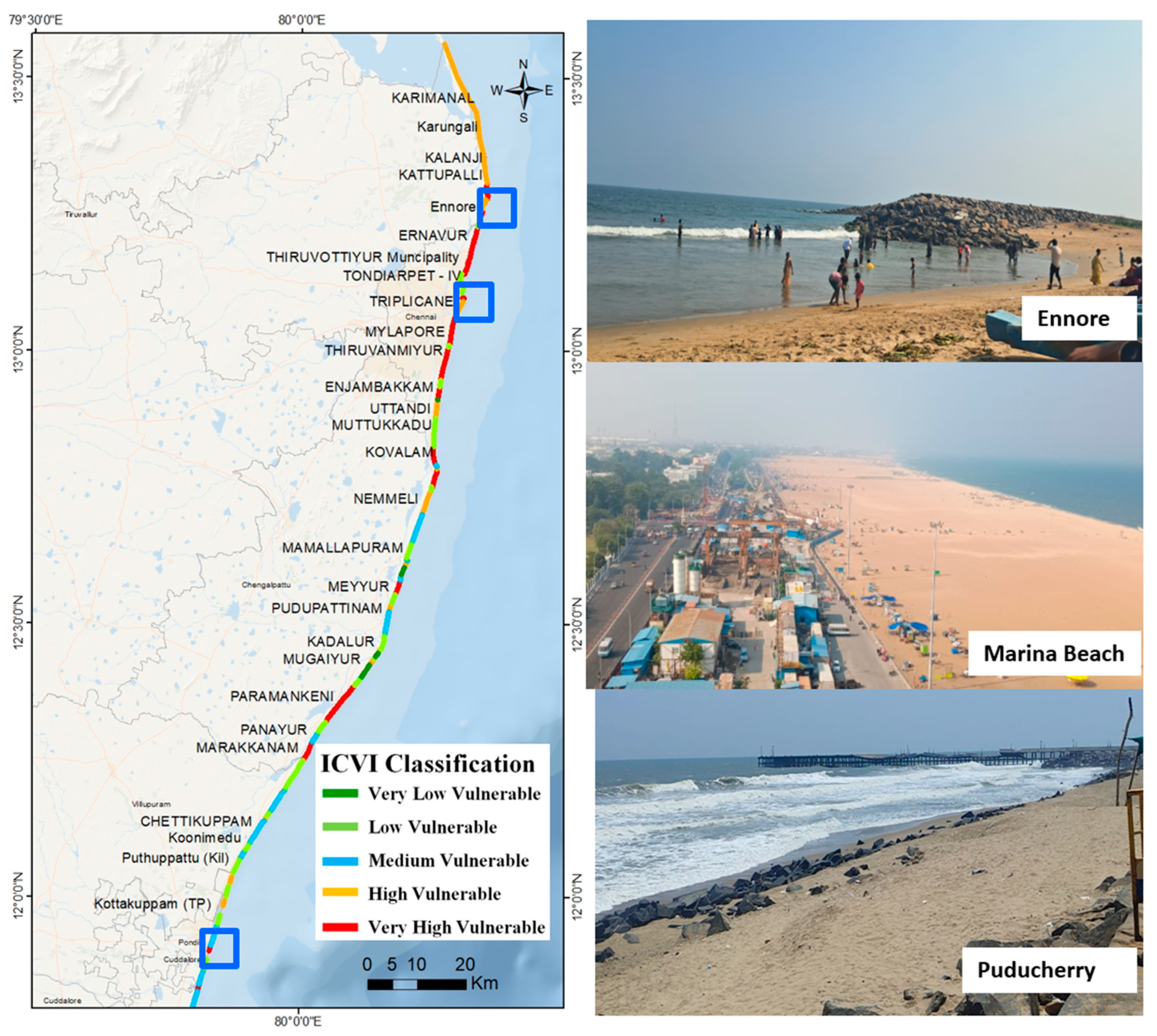
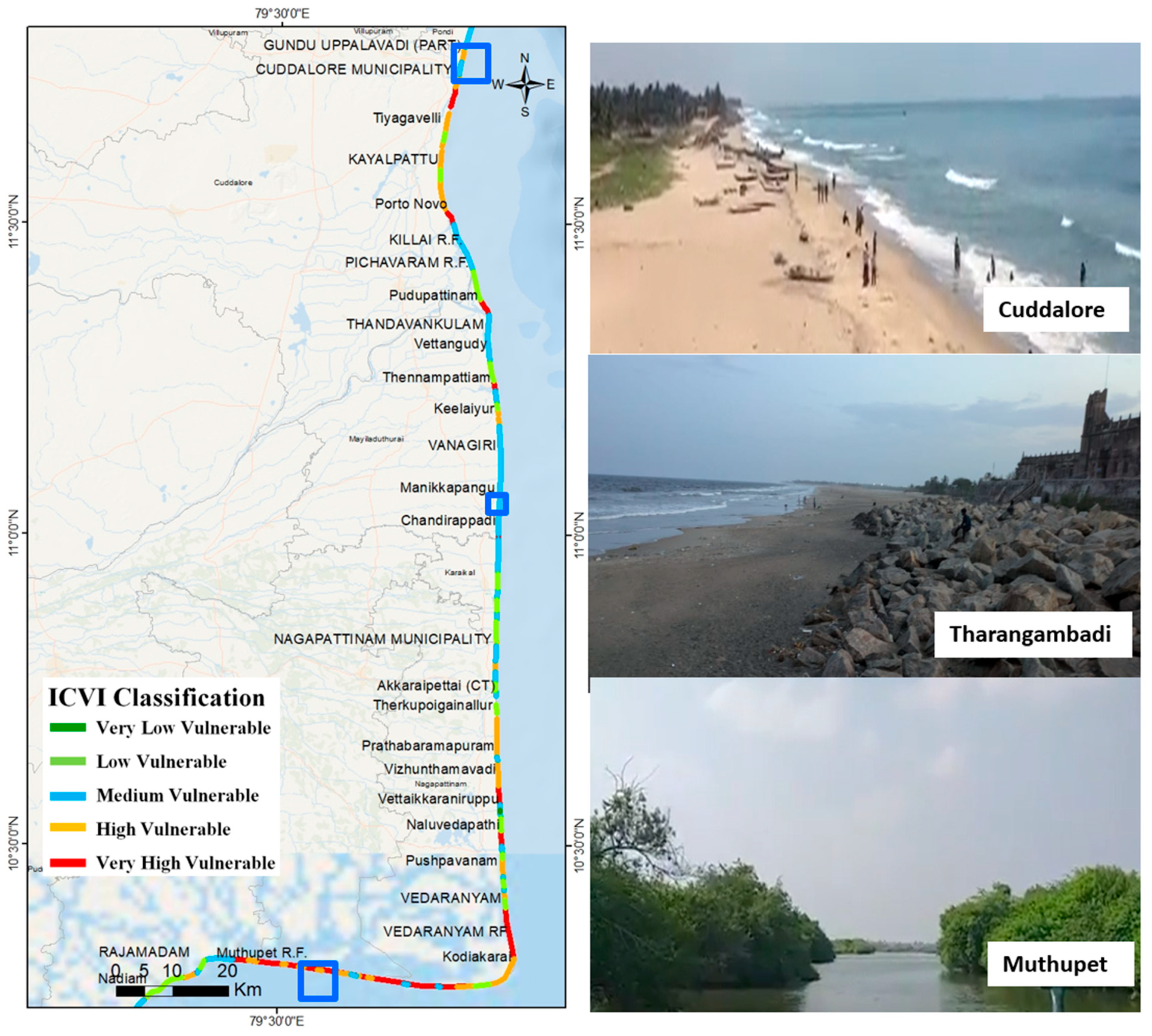
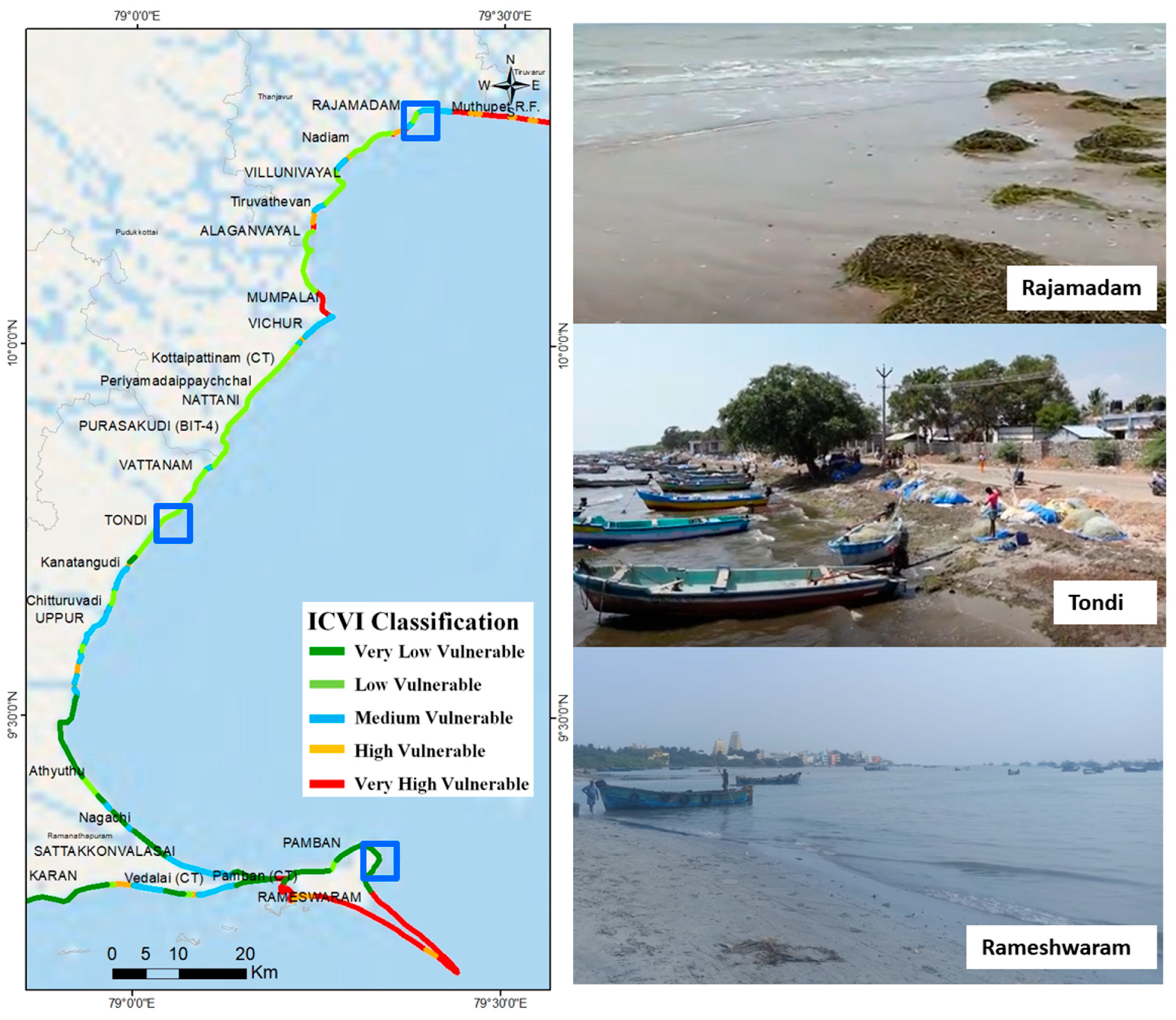
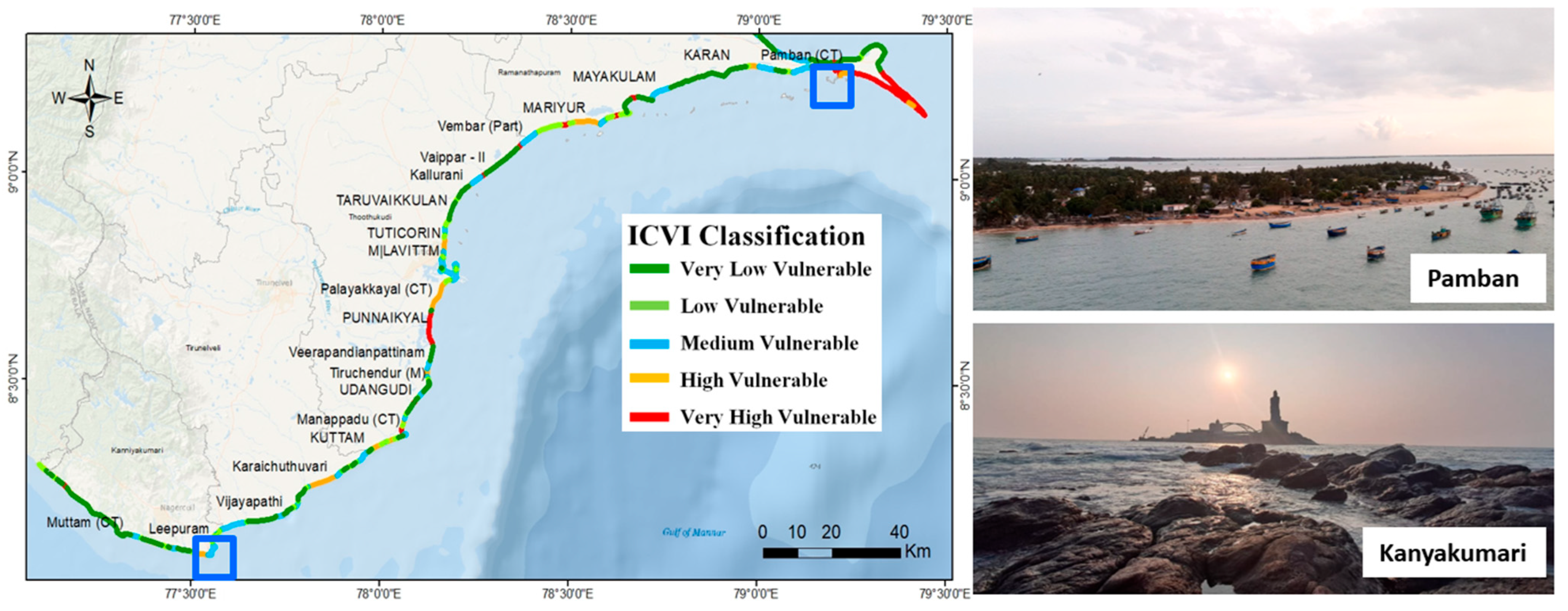
| Regions | District Names | Shoreline Length (km) |
|---|---|---|
| Zone 1 | Tiruvallur, Chennai, Chengalpattu, Villupuram, Puducherry | 232 |
| Zone 2 | Cuddalore, Mayiladuthurai, Karaikal, Nagapattinam, Tiruvarur | 227 |
| Zone 3 | Thanjavur, Pudukkottai, Ramanathapuram | 193 |
| Zone 14 | Ramanathapuram, Thuthookudi, Tirunelveli, Kanyakumari | 424 |
| Total | 1076 |
| Physical Parameters | |||
|---|---|---|---|
| Parameters | Data Source | Source Location | Period |
| Geomorphology | Sentinel-2, Landsat-8 | Bhukosh | 2025 |
| Elevation | Shuttle Radar Topography Mission (SRTM) | Open topography | 2024 |
| Slope | |||
| Bathymetry | National Oceanic and Atmospheric Administration (NOAA) Bathymetric Data | General Bathymetric Chart of the Oceans (GEBCO) | 2025 |
| Significant Wave Height (SWH) | Wave Buoys | ERA5, European Centre for Medium-Range Weather Forecasts (ECMWF) | 2025 |
| Tidal Range | WXTide32 | Tide Text | 2025 |
| Shoreline Change (SLC) | Sentinel-2, Landsat 4–9 | United States Geological Survey (USGS) | 1990, 1995, 2000, 2005, 2010, 2015, 2020, 2025 |
| Population Density | Survey of India | 2011 Senses | 2011 Senses |
| LULC | Landsat-8, Sentinel-2 | Supervised Classification | 2024 |
| Temperature, Rainfall, Coastal Inundation | Permanent Service for Mean Sea Level (PSMSL), Sixth Assessment Report (AR6), Shared Socioeconomic Pathways (SSP2 4.5) Mid-Century | Coupled Model Intercomparison Project (CMIP6) | Historical Period: 1984 to 2014, Predicted Period 2014–2040 |
| Parameter | Very Low (1) | Low (2) | Moderate (3) | High (4) | Very High (5) |
|---|---|---|---|---|---|
| Coastal Geomorphology | Aeolian sand dunes | Pediments, pediplains, salt marshes, mudflats | Anthropogenic terrain, alluvial plains, coral reefs, mangroves | Flood plains, delta plains, sand beaches, estuaries, lagoons | Coastal plains, waterbodies |
| Coastal Elevation (m) | ≥10 | 7.5–10.0 | 5–7.5 | 2.5–5 | <2.5 |
| Coastal Slope (°) | >3 | 2–3 | 1–2 | 0.5–1 | <0.5 |
| Bathymetry(m) | <40 | 30–40 | 20–30 | 10–20 | <10 |
| Tidal Range (m) | >0.5 | 0.5–1.0 | 1.0–1.5 | 1.5–2.0 | >2 |
| Significant Wave Height (m) | 0.5–0.75 | 0.75–1.0 | 1–1.25 | 1.25–1.5 | >1.5 |
| Shoreline Change (SLC) (m/year) | >2 | +1.0 to +2.0 | −1.1 to +1.0 | −1.1 to −2.0 | <−2.0 |
| Population Density (people/km2) | <500 | 500–1000 | 1000–1500 | 1500–2000 | >2000 |
| Land Use Land Cover (LULC) | Barren land | Forest | Crop land, water bodies, coastal areas, mangroves, salt pans | Agricultural land | Built up |
| Rising Temperature (°C) | <0.9 | 0.9–1 | 1–1.1 | 1.1–1.2 | >1.2 |
| Rainfall (% increases) | <10% | 10–20 | 20–30 | 30–40 | >40 |
| Coastal Inundation | No inundation | - | - | - | Inundation |
| Classification | PVI Range | SEVI Range | CVIc Range | ICVI Range |
|---|---|---|---|---|
| Maximum Range | 105.6 | 3.54 | 6.46 | 38.55 |
| Minimum Range | 0.38 | 0.71 | 0.578 | 0.55 |
| Very High Vulnerability | >60 | >3.0 | >5.5 | >30 |
| High Vulnerability | 40–60 | 2.5–3.0 | 4.0–5.5 | 20–30 |
| Moderate Vulnerability | 20–40 | 1.8–2.5 | 2.5–4.0 | 10–20 |
| Low Vulnerability | 10–20 | 1.0–1.8 | 1.2–2.5 | 3–10 |
| Very Low Vulnerability | <10 | <1.0 | <1.2 | <3 |
| Regions | District Names | Shoreline Length (km) | Major Vulnerable Parameters | Vulnerability Classification | Rank | Vulnerability (%) | Vulnerability (km) |
|---|---|---|---|---|---|---|---|
| Zone 1 | Tiruvallur, Chennai, Chengalpattu, Villupuram, Puducherry | 232 | Geomorphology, elevation, slope, shoreline changes, population, LULC, Coastal Inundation | Very low vulnerability | 1 | 2.128626 | 4.938413 |
| Low vulnerability | 2 | 19.46748 | 45.16456 | ||||
| Moderate vulnerability | 3 | 19.92606 | 46.22846 | ||||
| High vulnerability | 4 | 29.71663 | 68.94259 | ||||
| Very high vulnerability | 5 | 28.76119 | 66.72597 | ||||
| Zone 2 | Cuddalore, Mayiladuthurai, Karaikal, Nagapattinam, Tiruvarur | 227 | Geomorphology, elevation, slope, bathymetry, LULC, temperature, rainfall, Coastal Inundation | Very low vulnerability | 1 | 0.121202 | 0.27513 |
| Low vulnerability | 2 | 13.50042 | 30.64595 | ||||
| Moderate vulnerability | 3 | 30.10749 | 68.34399 | ||||
| High vulnerability | 4 | 26.20765 | 59.49135 | ||||
| Very high vulnerability | 5 | 30.06325 | 68.24358 | ||||
| Zone 3 | Thanjavur, Pudukkottai, Ramanathapuram | 193 | Geomorphology, elevation, slope, bathymetry, shoreline changes, temperature | Very low vulnerability | 1 | 28.89562 | 55.76855 |
| Low vulnerability | 2 | 38.00684 | 73.3532 | ||||
| Moderate vulnerability | 3 | 25.29815 | 48.82543 | ||||
| High vulnerability | 4 | 5.738729 | 11.07575 | ||||
| Very high vulnerability | 5 | 2.060663 | 3.97708 | ||||
| Zone 4 | Ramanathapuram, Thuthookudi, Tirunelveli, Kanyakumari | 424 | Significant wave height, LULC, temperature | Very low vulnerability | 1 | 31.071 | 131.741 |
| Low vulnerability | 2 | 9.930195 | 42.10403 | ||||
| Moderate vulnerability | 3 | 22.87017 | 96.96951 | ||||
| High vulnerability | 4 | 17.93613 | 76.04918 | ||||
| Very high vulnerability | 5 | 18.19251 | 77.13625 | ||||
| Total | 1076 |
Disclaimer/Publisher’s Note: The statements, opinions and data contained in all publications are solely those of the individual author(s) and contributor(s) and not of MDPI and/or the editor(s). MDPI and/or the editor(s) disclaim responsibility for any injury to people or property resulting from any ideas, methods, instructions or products referred to in the content. |
© 2025 by the authors. Licensee MDPI, Basel, Switzerland. This article is an open access article distributed under the terms and conditions of the Creative Commons Attribution (CC BY) license (https://creativecommons.org/licenses/by/4.0/).
Share and Cite
Arokiyadoss, P.; Narasimhan Chandrasekaran, L.; Andimuthu, R.; Syed Noor, A.I. Assessment of Integrated Coastal Vulnerability Index in the Coromandel Coast of Tamil Nadu, India Using Multi-Criteria Spatial Analysis Approaches. Sustainability 2025, 17, 6286. https://doi.org/10.3390/su17146286
Arokiyadoss P, Narasimhan Chandrasekaran L, Andimuthu R, Syed Noor AI. Assessment of Integrated Coastal Vulnerability Index in the Coromandel Coast of Tamil Nadu, India Using Multi-Criteria Spatial Analysis Approaches. Sustainability. 2025; 17(14):6286. https://doi.org/10.3390/su17146286
Chicago/Turabian StyleArokiyadoss, Ponmozhi, Lakshmi Narasimhan Chandrasekaran, Ramachandran Andimuthu, and Ahamed Ibrahim Syed Noor. 2025. "Assessment of Integrated Coastal Vulnerability Index in the Coromandel Coast of Tamil Nadu, India Using Multi-Criteria Spatial Analysis Approaches" Sustainability 17, no. 14: 6286. https://doi.org/10.3390/su17146286
APA StyleArokiyadoss, P., Narasimhan Chandrasekaran, L., Andimuthu, R., & Syed Noor, A. I. (2025). Assessment of Integrated Coastal Vulnerability Index in the Coromandel Coast of Tamil Nadu, India Using Multi-Criteria Spatial Analysis Approaches. Sustainability, 17(14), 6286. https://doi.org/10.3390/su17146286






